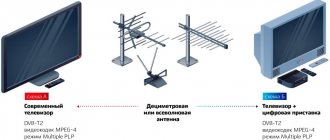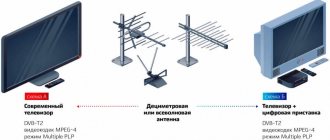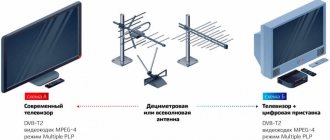Every TV viewer sooner or later wonders how digital television differs from analogue television. This issue is especially relevant now that the country is completely abandoning analogue television broadcasting. In short, the difference lies in the method of signal transmission. Digital broadcasting is much better protected from interference, which provides high-quality picture and sound and allows you to broadcast several hundred TV channels at once instead of several dozen.
How analog and digital signals are transmitted
The main difference between an analog signal and a digital one is that the first is transmitted in a continuous stream, which is easily influenced by external factors that degrade the quality of the output image. The digital signal is discrete, or intermittent, which helps protect it from interference.
An electrical analog signal consists of three elements:
- video signal, which contains data on the brightness of the picture;
- a color subcarrier in which color data is encrypted;
- sound signal.
It can be broadcast via radio from terrestrial TV stations or via cable.
Important! It is worth noting that analogue cable channels will continue to operate, ATV broadcasting will stop only in the terrestrial broadcasting system.
To watch analog television, it is enough to have a TV to which a regular VHF antenna is connected via a coaxial cable.
A digital broadcast signal, or DTV, is compressed binary code. This technology allows for the transfer of large amounts of information. Thanks to this, TV viewers can choose from hundreds of channels. Today in Russia digital TV is broadcast in the DVB-T2 standard. In order to watch DTV, you need an antenna and a receiver that will decipher the encoded signal. This usually needs to be purchased separately, but most TVs made after 2013 have a built-in receiver.
What are the advantages of digital television
The complete transition to DTV is due to the fact that in many respects this technology is superior to ATV. So, the advantages of digital television over analogue are as follows:
- increased resistance to interference and, as a result, better picture and sound quality;
- the ability to broadcast images in HD and UHD quality, as well as in 3D format;
- stereo and surround sound support;
- a large number of TV channels;
- subtitle support;
- interactive TV systems that allow the viewer to influence the programs being watched (record, pause, move to the beginning of the program, and so on);
- the ability to switch between audio tracks in different languages and select the subtitle language;
- archive of television programs;
- TV guide;
- cinema hall;
- availability of radio channels in the multiplex;
- reduction in transmitter power.
TV viewers can watch from 10 to 20 channels for free, enjoying high quality video and taking advantage of a number of other advantages of DTV . To get more TV channels, you will need to purchase a package from one of the TV operators.
Types of digital TV
When talking about digital television, we usually mean terrestrial terrestrial DTV. However, terrestrial, cable, satellite and mobile TV can be broadcast in digital format.
Essential
The peculiarity of broadcasting is that the signal is broadcast over a terrestrial radio channel and can cover a limited area. As a rule, the coverage radius ranges from 30-100 km and depends on the power of the tower.
To receive terrestrial DTV you need:
- collective or individual UHF antenna;
- digital set-top box;
- TV that supports the DVB-T standard
So, when switching from terrestrial analogue to digital television, there is no need to change the antenna if it operates in the decimeter range.
Cable
The name reflects the essence of how a television signal is transmitted. It runs from the central headend to the subscriber's TV through a network of fiber optic cables. In the Russian Federation, CATV broadcasts are carried out in the DVB-C standard.
Cable television provides high-quality picture even in areas densely built up with high-rise buildings, where terrestrial TV users often have problems due to the fact that the radio signal is reflected from houses. Also, the television signal transmitted via cable is not affected in any way by weather conditions.
Important! To receive digital CATV, you need a set-top box with a module that will transmit the decrypted signal to the TV.
Satellite
In this case, the artificial satellites of the planet act as relays. From the transmitting center the signal is sent to satellites, and they relay it to Earth. This ensures coverage of most areas where broadcasting from conventional television towers is impossible.
In Russia, satellite TV is transmitted in the European standard DVB-S2. To receive it you need the following equipment:
- satellite antenna;
- converter;
- console.
New TVs often already have a built-in receiver that decrypts the signal.
DVB-T2 standard support
Unfortunately, even the presence of the necessary jacks does not mean that the TV will be able to display digital channels broadcast in our country. Currently, the broadcast is carried out according to the European terrestrial television standard - “DVB-T2”. The TV receiver must not only support a digital television signal, but also its specific standard.
It is not always possible to determine which digital standard is supported by a TV by examining it (unless there is the inscription “DVB-T2” next to the socket panel). In this case, you will have to refer to the instructions for the television receiver, which will necessarily indicate the types of television signals it receives.
If you don’t have instructions, you can always visit the TV manufacturer’s website or simply enter its model into the search engine Yandex, Google, etc. Next, it remains to study the technical characteristics of the TV receiver. For example, this is what the standard table of TV parameters looks like on the manufacturer’s website:
In this case, the TV supports both the first (DVB-T) and second (DVB-T2) generations of terrestrial digital television.
How to find out what kind of TV your TV shows: digital or analogue
Until October 14, 2021, analogue broadcasting will be stopped in those regions where it is still ongoing. Therefore, TV viewers want to understand what kind of TV they watch.
This question is relevant for residents of regions where both types of broadcasting are carried out. We are talking about the following territories:
- St. Petersburg and Leningrad region;
- Murmansk region;
- Vologda region;
- Pskov region;
- Belgorod region;
- Kaluga region;
- Kursk region;
- Astrakhan region;
- Volgograd region;
- Orenburg region;
- Saratov region;
- Chelyabinsk region;
- Altai Republic;
- Republic of Karelia;
- Republic of Crimea;
- Republic of Bashkortostan;
- Transbaikal region.
Residents of these regions have several ways to find out what kind of television is working in their home.
- Check if there is a letter “A” next to the name of the TV channel. It is used to designate analog channels; accordingly, if it is present, the TV shows ATV.
- If the TV is old and works without a receiver, it means analog television is connected.
- If the TV can receive an encoded signal without a receiver, you can determine the type of broadcast using the antenna plug. You need to take it out and hold it at a distance of half a centimeter from the socket. If the picture quality deteriorates, but the TV continues to show, it means that analog TV is being received. If the video disappears completely, DTV is connected.
- You can open the “Signal Source” section in the TV menu.
- Digital television is better than analogue in terms of picture quality, and if the picture is bright and very clear, it is most likely DTV.
It’s worth figuring out in advance what signal the TV receives so that you don’t end up without TV in the fall.
Important! Citizens who live in other regions and are connected to terrestrial TV definitely watch DTV, since they no longer have ATV.
How to understand that you are watching analog TV and switch to digital broadcasting
On February 11, analogue television broadcasting will be turned off in several regions of the country: Ryazan, Tula, Yaroslavl, Ulyanovsk, Penza, Magadan regions and the Chechen Republic. On April 15, another 20 regions will switch to digital, and on June 3, the remaining 57.
What needs to be done to avoid being left without television, and who is entitled to compensation for the purchase of digital set-top boxes.
What is analogue and digital television broadcasting?
Analogue television broadcasting is a familiar type of broadcasting, when the signal broadcast from television towers is received by an antenna. Digital broadcasting is a technology for transmitting images and sound using digital coding.
From the consumer’s point of view, digital TV implies higher quality of “picture” and sound, good reception even in hard-to-reach settlements.
The transition to digital television broadcasting is taking place within the framework of the federal target program “Development of television and radio broadcasting in the Russian Federation for 2009–2018.” By 2021, digital television networks were launched throughout the country.
How can I check if my TV is ready to switch to digital? And what if not?
You need to turn on any of the central channels (Channel One, Russia 1, Channel Five, STS, TNT, NTV and others) and look carefully at the TV screen. If you see the letter “A” next to the channel logo, then you have analog broadcasting.
If you have a modern TV made after 2012, most likely it supports the DVB-T2 digital standard, you just need to configure it for the new broadcast. If your TV does not support this standard, you can connect a DVB-T2 digital set-top box.
Where to buy a digital set-top box?
In any electronics and household appliances store. Retailers have already created stocks of DVB-T2 set-top boxes in their warehouses and promise that there will be enough goods for everyone. The average price of the device is from 700 to 1.5 thousand rubles. Also, set-top boxes for receiving digital signals are sold at Russian Post branches in more than 30 regions of the country.
And Russians who have social benefits can receive monetary compensation for purchasing the necessary equipment.
Who exactly can receive these compensations?
Payments are provided for the following categories of citizens:
- WWII veterans and former minor prisoners of fascism;
- disabled people of the Second World War and combat operations;
- family members of deceased (deceased) disabled people and participants in the Great Patriotic War;
- non-working single pensioners who do not belong to preferential categories;
- elderly people living in families consisting of non-working pensioners;
- low-income families;
- low-income single Russians receiving social assistance.
You can apply for payments from September 1, 2021 to June 30, 2019. You can apply for compensation through government services.
How difficult is it to retune the broadcast? I'll deal? What about my retired parents?
It is not difficult. If you follow the instructions for the equipment, the process will take a few minutes. Also, since last year, a federal 24-hour hotline on digital TV connections has been operating for Russians. The call is free: 8-800-220-20-02, line operators will help you choose equipment and tell you how to connect the set-top box.
In addition, for pensioners, but not only for them, but for everyone, volunteer centers have been opened in the regions of the first wave, where you can get help in switching to digital TV.
Thus, in the Ryazan region, volunteers helped install equipment for 1.5 thousand residents; they were mainly approached by elderly people and residents of remote settlements. Assistance consists of consultations and, if necessary, visiting the site and setting up equipment. Volunteers provide these services free of charge.
There are also such centers in other regions, where the shutdown of analogue transmitters will occur later. For example, in Samara, a volunteer center is already operating on the basis of the Volga Region University of Telecommunications and Informatics.
Could it happen that TVs will show poorly after switching to digital?
There shouldn't be any problems. The transition to digital broadcasting in the Tver region, which became a pilot region in December 2021, was successful. The regions of the first wave are fully prepared to switch off the analog signal, according to the Russian Ministry of Telecom and Mass Communications.
“None of the seven regions of the first stage, which are switched off on February 11, does not cause us the slightest concern,” said Alexey Volin, Deputy Minister of Digital Development, Communications and Mass Communications of the Russian Federation. “I can also say that our constant contacts with 20 regions of the second stage, which are switching off on April 15, show that the vast majority of them are already ready for a full transition to digital.”
tass.ru
TAGS:IT technologies in RussiaHigh technologiesChanges in Russia in 2021Quality of Russian televisionMinistry of CommunicationsRussian newsNew technologies in RussiaRussiaTASSTechnological progressDigital television in Russia











